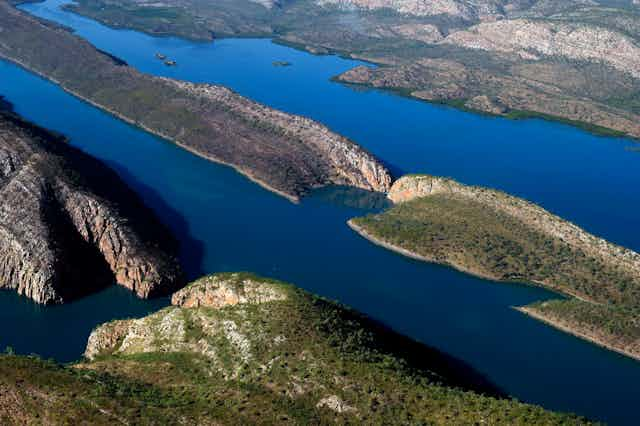The Western Australian Minister for Environment and Heritage, Albert Jacob, has recently released the draft plan for conservation management in and around the Kimberley’s Horizontal Falls region.
This region takes in the proposed Lalang-garram (Horizontal) Falls and North Lalang-garram marine parks, and Oomeday National Park, and forms part of the much bigger proposed Great Kimberley Marine Park and Wanjina National Park.
Mr Jacob is asking “West Australians … to have a say on the future of one of the world’s most significant cultural and natural tourist attractions - Horizontal Falls and surrounding areas on WA’s Kimberley coast”.
The culturally important Horizontal Falls is situated in the ancestral country of the saltwater Dambimangari people.
The land is Aboriginal Reserve Land, reserved for the use and benefit of Aboriginal people, and they have exclusive possession native title over the area.
Dambimangari country is already included within Australia’s National Reserve System and is currently being managed by a team of Dambimangari rangers within International Union for Conservation of Nature Category VI standards as the Dambimangari Indigenous Protected Area.
Mr Jacob is proposing is the Dambimangari people surrender exclusive control of their ancestral lands to enter into a joint-management arrangement with the West Australian Government.
For some, this choice presents a watering down of Indigenous peoples’ rights to make decisions and manage their ancestral lands independently according to their own Law and custom.
The head of the Kimberly Land Council, Mr Nolan Hunter, has cautioned that traditional owners shouldn’t have their rights undermined.
Indigenous conservation
Over the past 30 years there has been a monumental change in international and national approaches to biodiversity and conservation management.
In many places this has involved a move away from colonial notions of “wilderness” areas that excluded Indigenous peoples from their ancestral lands and seas, to models that now take into account their aspirations and property rights.
Many of the world’s terrestrial and marine protected areas are now seen as part of, rather than separate from, Indigenous development initiatives.
Australia at times has been a world leader in experimenting with joint-management arrangements for protected areas.
In 1981, Gurig National Park, on Cobourg Peninsula northeast of Darwin, became the first jointly-managed National Park in Australia.
Kakadu, Uluru-Kata Tjuta, Nitmiluk and Booderee National Parks followed under various legal partnerships and management structures, which attempt to balance the rights and interests of Indigenous peoples, tourists, environmentalists, developers and governments.
In the 1990s, Australia was again leading the world in working with Indigenous peoples to develop Indigenous Protected Areas (IPAs).
An IPA is an area of land and/or sea country which has been voluntarily declared to be a protected area by its Indigenous traditional owners.
IPAs are managed by Indigenous people according to international guidelines and recognised by Commonwealth, State and Territory governments as part of Australia’s National Reserve System.
Today, there are over 70 IPAs throughout Australia, contributing over 40% of Australia’s National Reserve System.
IPAs are vital in achieving Australia’s obligations under the UN Convention on Biological Diversity. Vital for both conservation outcomes and recognising Indigenous peoples’ rights to nature.
IPAs are seen by many Indigenous people as being far superior to older style joint-management arrangements where there is always pressure from the more powerful partner for compromise.
IPAs (whether tenure-based or country-based) provide the opportunity for Indigenous-led consensual partnerships, while joint-management arrangements typically involve government-led coercive partnerships.
For example, in 2009 Environment Minister Peter Garrett, with the support of Prime Minister Kevin Rudd, overrode the wishes of the traditional owners of Uluru that tourists not climb their sacred site.
Many Australian property owners take the right to exclude others as a given. After all, it’s the property owners who decide who’s allowed in their backyards and who’s not.
By avoiding coercive relations, IPAs provide a critical pathway for Indigenous-led collaborative partnerships, as currently occurs in Northeast Arnhem Land with the Dhimurru IPA.
The Dambimangari IPA
Back in the Kimberley, Donny Woolagoodja, a Dambimangari traditional owner, voiced concerns in the Dambimangari IPA plan :
[We are] concerned about unmanaged access by tour operators and private boaters, and the protection of marine resources … These are big issues that have been worrying us for a long time.
Just as the Anangu have expressed concerns about tourists at Uluru climbing their sacred site, the Dambimangari people have “frequently voiced our concerns about the safety of tourists going through the Horizontal Waterfalls.”
They say, “we are happy for visitors to come to Dambimangari country if it is done the right way”.
Through the IPA, Dambimangari people made a decision to manage this sacred site according to their Law and custom.
To achieve this they intend establishing a permit system to manage culturally important places like Horizontal Falls.
However, under the Mr Jacob’s proposal, the decision about who enters Dambimangari property and how they behave will in the future need to be made with the agreement of the State government.
This is the same government that remains committed to closing Indigenous homelands and weakening statutory protection for sacred sites across the state.
If Dambimangari traditional owners enter into the proposed joint-management framework for the national park with the West Australian Government they will have to surrender control of their country to accommodate their powerful partner’s wishes, just as the Anangu have had to do for decades now at Uluru.
Seán will be on hand for an Author Q&A between 2 and 3pm AEDT on Thursday, November 19, 2015. Post your questions in the comments section below.

